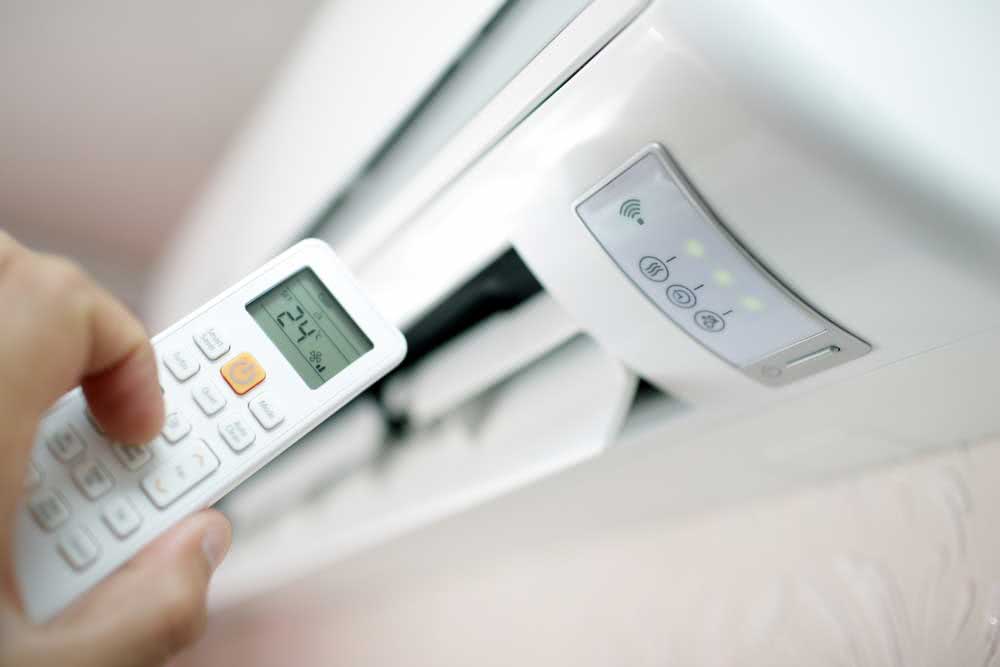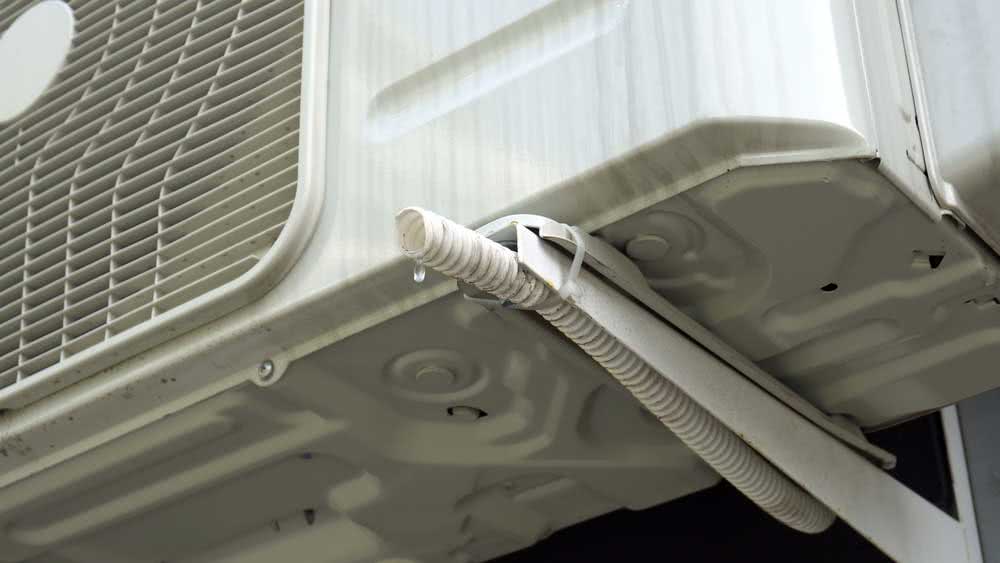Air conditioner dripping water is a sign of a problem and that your unit is probably not working properly.
There are several causes for this, from the simplest to be solved to the most complex. But regardless of what caused the problem, one thing is certain: if the drip tray is not fixed in time, you run a serious risk of losing the air conditioner.
But calm down, that won’t happen! That’s because this post here is full of tips and information to help you solve this dilemma. Check out.
Air Conditioner Dripping Water: Common Causes and How to Fix It

1. Installation device incorrect
One of the biggest reasons behind an air conditioner leaking water is the incorrect installation of the unit, especially if your air conditioner is new.
In this case, most likely the appliance’s evaporator was installed crookedly on the wall. It may also happen that the piping used in the installation is of a smaller diameter than that recommended by the manufacturer.
Another common situation that ends up causing problems with the air conditioning is the connection of other appliances in the same pipe.
Therefore, the first thing you should do is analyze how the installation was carried out and, if you notice any defects, contact the technician responsible for the installation.
2. Dirt in the air conditioner
On the other hand, an air conditioner that has been in use for a longer period of time may have water droplets due to the accumulation of dirt inside the device.
The lack of cleaning of filters and other components is extremely harmful to the health of the air conditioner.
Therefore, periodic cleaning of the filters, condenser tray and evaporator is essential.
This cleaning must be carried out fortnightly for appliances that remain on for a long time. But if your air conditioner is not used frequently, the time between cleaning and cleaning can be more spaced, with a maximum interval of thirty days, on average.
If you are in doubt about how to clean the air conditioner, call a technician you trust to carry out the service.
3. Air leak
The air conditioner dripping water can also mean air leakage or poor sealing.
If the appliance has not been properly sealed, hot air accumulates on the outside causing droplets of water to condense on contact with cold air.
The solution for this, however, is simple: just make a new seal, making sure that the device is completely sealed.
4. Freezing the coil
The freezing of the coil located inside the unit can also result in an air conditioner dripping with water.
The most common reason for this to happen is the accumulation of dirt on the part. This is because excess dust and other debris prevent the air from passing through, causing it to freeze inside the device and, consequently, end up resulting in water drops on the outside of the air conditioner.
To identify this problem you should place your hands on the device to feel if it is cold. If you notice that it is very cold, then there is a strong indication that the coil is frozen.
However, this type of problem must be solved by a specialized professional, since these are difficult parts to be reached and removed, in addition to which the cleaning of these components is also differentiated.
5. Climate and temperature
In some rarer cases it may happen that the air conditioner suffers a thermal shock due to sudden changes in temperature.
That’s because most devices are programmed to work in a certain temperature range that varies between 15ºC and 33ºC.
When temperatures drop or rise too high, the device “works” too much, resulting in wear on internal parts and components.
In addition to temperature changes, leaky air conditioning can also mean high humidity. In these cases, the ideal is to call a technician to assess where the problem is and, thus, carry out the necessary repairs.
6. Drain obstruction
A clogged or blocked drain is another factor that causes the air conditioner to leak water. And guess why the drain gets clogged? Dirt inside the appliance. See how important cleaning is?
But it’s not just dirt that can clog the drain. Another reason for this to happen is the unevenness of this component. If the drain is out of level, water can also leak out of the appliance.
Therefore, it is worth checking how well your air conditioner drain is doing.
7. Burnt bomb
The drain pump can burn from the excess dirt inside, causing the air conditioner to start dripping on the outside.
However, not all devices have a drain pump. This part is only installed when there are no drain points nearby. If this is the case, it is important to check the pump and whether it is in need of maintenance and cleaning.
8. Turbine
The air conditioning turbine can also be a factor for the drip pan on the outside of the appliance.
This can happen if the turbine starts to run below capacity, making the device slower and less efficient.
This type of problem can only be evaluated by a specialized technician, but it is good to know so be aware.
If a problem is found in the turbine, the replacement of the part ends up being unavoidable.
How to Avoid Air Conditioning Problems

You may have noticed that many of these problems can be easily avoided with a routine braces care.
Therefore, we have listed below the main procedures to prevent your air conditioner from leaking again, besides, of course, preventing other defects as well. Check out:
1. Periodic cleaning
The cleaning of the air conditioning must always be kept up to date. This is because, as you can see, the accumulation of dirt is harmful to various components of the device, making it inefficient over time.
That’s why you should make it a habit to clean the filter every fortnight if the device is used too often. On the other hand, appliances that are less used can be cleaned once a month.
But cleaning is always necessary, even if the appliance spends days and even weeks off, as dust continues to accumulate inside the parts.
In addition to cleaning the filter, it is also important to clean other components, such as trays and coils, but less frequently.
However, for this type of cleaning it is necessary to call a specialized technician to disassemble the device, sanitize what is necessary and then assemble everything again.
2. Preventive maintenance
Preventive maintenance serves both to clean certain types of parts that are more difficult to reach, as well as to assess the general condition of the appliance.
During maintenance, the technician evaluates the entire drainage system, coils, drains, the appliance’s sealing, gas and cooling system, in addition to other important details, such as the connection of electrical cables and piping.
Maintenance of the air conditioning must be carried out considering the frequency of use of the appliance. As a general rule, the more you use it, the more maintenance is required.
But, by default, periodic maintenance is recommended per year for home air conditioners and maintenance every six months for commercial or large-person appliances.
And what do you get with preventive maintenance? Many things! First, you guarantee the useful life of the device and prevent possible breakdowns and damage. Another good reason to perform maintenance is energy savings. That’s because an air conditioner that works properly will require less electricity.
Want one more reason? Preventive maintenance is good for your health and that of your family. The accumulation of dust and other dirt inside the device is an excellent refuge for mites, bacteria and other microorganisms harmful to human health.
By carrying out preventive maintenance, you guarantee cleaner and healthier air, favoring the health of everyone, especially those who have respiratory problems such as rhinitis, bronchitis and asthma.
3. Trained technicians
When carrying out periodic maintenance on your device, it is essential to rely on the work of specialized and qualified technicians.
Avoid hiring the “does everything”, the loss can be great. And one more tip: prefer companies and professionals recommended by the manufacturer’s technical assistance, in order to avoid losing the device warranty.



